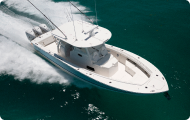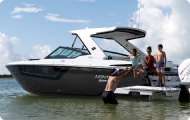If you enjoy boating near the coast, it’s important to know about tides and currents. Understanding these can help keep you safe and make your time on the water more fun. Here’s a simple guide to help you understand tides and currents for safe boating.
What Are Tides?
Tides are the natural rise and fall of ocean water caused by the gravitational pull of the moon and the sun. Understanding tides is essential for boaters, as they can significantly impact your docking and navigation.
High Tide: This occurs when the water level is at its highest. During high tide, water covers more of the beach or shoreline, which can change docking conditions and make navigation easier in certain areas.
Low Tide: This is when the water level is at its lowest. Low tide exposes more sand, rocks, and other obstacles, so boaters need to navigate carefully to avoid shallow areas that could impact the boat.
For boats designed to handle varying water depths, consider models such as the 2024 Sportsman 247 OE and Jeanneau Leader series. These boats often feature outboard engines that can be lifted or “trimmed” to accommodate shallower waters, making them highly versatile for different water conditions. Outboards are especially useful in coastal areas with varying tides, as they can be adjusted to avoid submerged hazards during low tide.
What Are Currents?
Currents are the flow of water in a certain direction. They can be caused by tides, wind, and the shape of the coast.
Outgoing Current: This happens when water flows away from the shore, often during low tide. It can carry your boat farther out if you’re not careful.
Incoming Current: This happens when water flows toward the shore, often during high tide. It can help bring you back in, but it can also be strong, so pay attention to your speed.
Why Understanding Tides and Currents Matters
Safety: Knowing when the tides are high or low helps you avoid shallow or rocky areas where your boat could get stuck or damaged.
Navigation: Understanding currents helps you plan your route. You can use incoming currents to help you get back to shore or avoid being pushed off course by outgoing currents.
Timing: Tides change regularly, so check tide charts before you go out. This way, you’ll know when to leave and when to come back.
At Thunder Marine, we proudly offer a selection of top-tier boating brands equipped with modern navigation and planning technology. Among our popular options are Jeanneau and Regulator models, both known for their advanced navigation features. Jeanneau, in particular, is known for its user-friendly electronic systems and seamless integration with popular marine apps to support route and tide planning. Our sales team is here to help you explore these innovative features and find the perfect boat to enhance your time on the water.
Additionally, our Regulator boats are often outfitted with advanced electronics designed for fishing and offshore adventures. To learn more about specific models and the cutting-edge navigation technology they feature, visit our Thunder Marine dealerships in St. Petersburg. Our knowledgeable sales team is always ready to provide tailored guidance on the features and technology options available to enhance your boating experience.
How to Prepare for Tides and Currents
Check Tide Charts: Before boating, look at local tide charts. They tell you when high and low tides are, so you can plan your trip.
Learn About Local Currents: Find out how strong the currents are in the area where you’ll be boating. Some places have stronger currents that can affect your speed.
Plan Your Route: Use the tide and current information to pick the best route. If you know a current is strong, allow extra time to reach your destination.
Stay Aware While Boating: Always watch the water around you. Look for changes in water level and notice how the current is flowing.
Knowing about tides and currents is important for anyone who loves coastal boating. By understanding how they work and planning ahead, you can stay safe and enjoy your time on the water. So, next time you go out, remember to check the tides and be aware of the currents for a great boating experience!
And remember: It’s not just a boat, it’s a lifestyle!

























